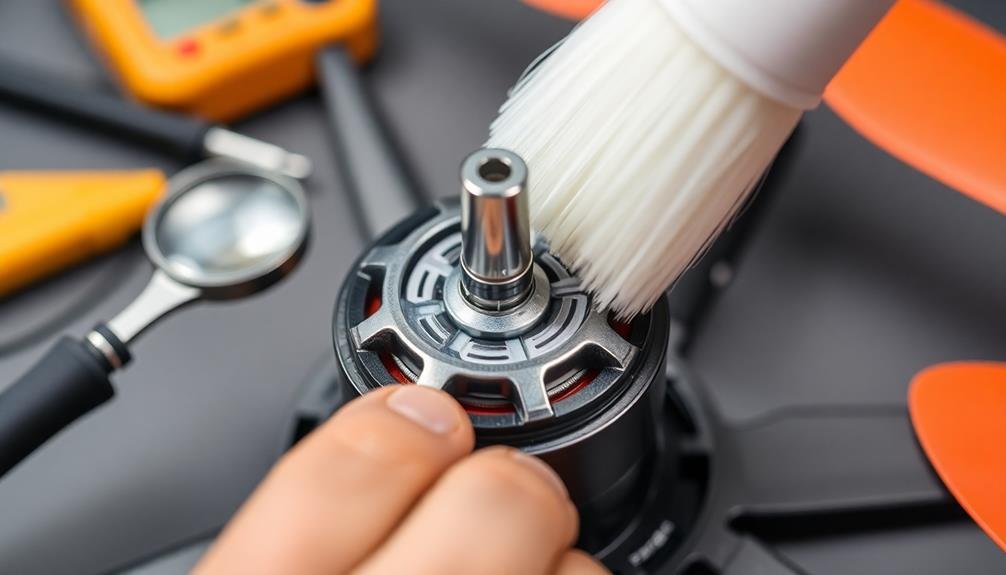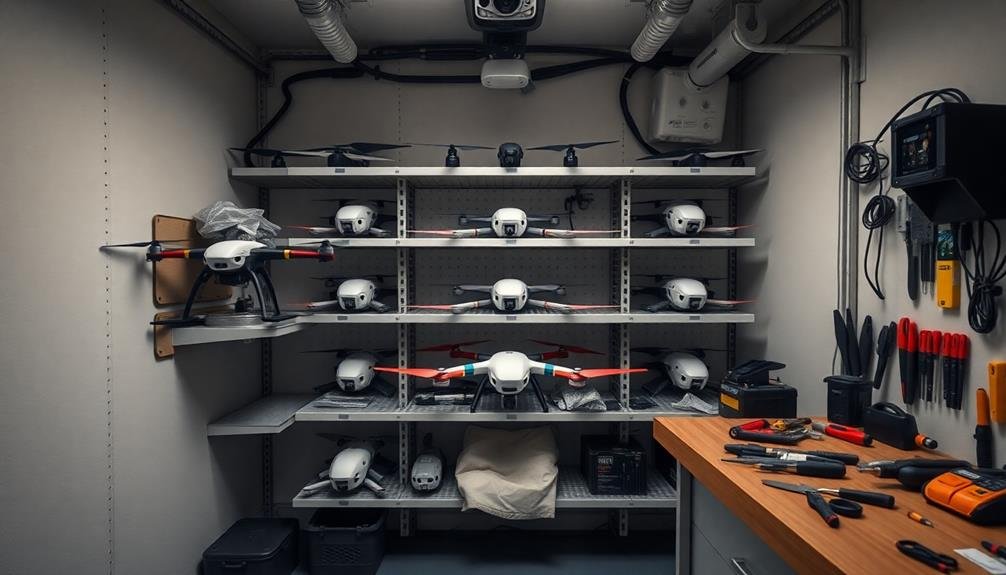To keep your UAV motors in top shape, follow these seven essential tips: Regularly clean and inspect them for damage or debris. Store your UAV properly in a cool, dry place. Use balanced propellers to reduce vibrations and stress. Lubricate moving parts according to the manufacturer's recommendations. Check electrical connections and wiring for wear. Keep firmware updated for peak performance. Schedule professional maintenance services annually or every 100 flight hours. By incorporating these practices into your routine, you'll extend your UAV's lifespan and guarantee smoother flights. Dive deeper to discover more detailed insights on each of these vital care tips.
Key Takeaways
- Regularly clean and inspect motors, removing debris with compressed air and checking for wear or damage.
- Lubricate moving parts according to manufacturer specifications, typically every 20-30 flight hours.
- Balance propellers to reduce vibrations and motor stress, replacing damaged or worn propellers promptly.
- Check and maintain electrical connections, including soldering points and wiring harnesses, to prevent failures.
- Keep firmware updated and conduct system verifications after updates to ensure optimal performance and safety.
Regular Cleaning and Inspection

Dust and debris are the enemies of UAV motors. To keep your motors running smoothly, you'll need to establish a regular cleaning and inspection routine. After each flight, visually check your motors for any signs of damage or foreign objects. Use compressed air to blow out any dust or particles that may have accumulated during operation.
Once a week, perform a more thorough cleaning. Remove the propellers and use a soft brush to gently clean the motor bells and stators. Pay close attention to the bearings, as they're particularly susceptible to damage from debris.
Apply a small amount of electronics cleaner to remove stubborn grime, but be careful not to oversaturate the components.
During your inspection, look for signs of wear on the motor windings, loose screws, or any unusual discoloration. Check that the shaft spins freely without any grinding or resistance.
Listen for any unusual noises when running the motors at low speeds. If you notice any issues, address them immediately to prevent further damage.
Proper Storage Practices

When your UAV isn't soaring through the skies, it needs a safe haven. Proper storage practices are vital for maintaining your UAV's motors and extending their lifespan. Always store your drone in a cool, dry place to prevent moisture damage and corrosion. Use a dedicated case or bag to protect it from dust and accidental impacts.
Before storage, remove the propellers and batteries. This prevents unnecessary stress on the motors and reduces fire risks. Clean the motors thoroughly and make certain they're completely dry before putting your UAV away. If you're storing it for an extended period, consider using silica gel packets to absorb any residual moisture.
Here's a quick guide to proper UAV storage:
| Storage Aspect | Do's | Don'ts |
|---|---|---|
| Environment | Cool, dry place | Humid or hot areas |
| Protection | Use a case or bag | Leave exposed |
| Components | Remove props and batteries | Store fully assembled |
| Maintenance | Clean and dry motors | Store dirty or wet |
Balanced Propellers for Smooth Operation

How can you guarantee your UAV motors run smoothly? One essential factor is using balanced propellers. Unbalanced props can cause vibrations, leading to motor stress and reduced flight performance.
To verify your propellers are balanced, you'll need a balancing tool and some patience. Start by placing each propeller on the balancing rod. If it tilts to one side, it's unbalanced. Use small pieces of tape on the lighter side or carefully sand down the heavier side to achieve balance. Repeat this process for both horizontal and vertical orientations.
Don't forget to check your propellers regularly for damage or wear. Even minor nicks can throw off the balance. Replace props that show signs of damage immediately.
When installing new propellers, always balance them before use. For peak performance, consider investing in high-quality, pre-balanced propellers. These often require less adjustment and provide more consistent results.
Lubrication of Moving Parts

To keep your UAV's motor running smoothly, you'll need to focus on proper lubrication of moving parts.
Start by selecting the right lubricant for your specific motor type and operating conditions.
You should also establish and follow a regular maintenance schedule to guarantee consistent lubrication and prevent wear on critical components.
Proper Lubricant Selection
Choosing the right lubricant for your UAV's motor is vital for ideal performance and longevity. You'll need to take into account factors like the motor type, operating conditions, and environmental factors when selecting a lubricant.
For brushless motors, which are common in many UAVs, you'll want to use a lightweight oil or grease. Synthetic oils are often preferred due to their stability and resistance to temperature changes. Look for products specifically designed for RC motors or small electric motors.
If you're operating in dusty or humid environments, opt for a lubricant with good sealing properties to prevent contaminants from entering the motor. For high-temperature applications, choose a lubricant with a high viscosity index that maintains its properties under heat.
Don't forget to check your manufacturer's recommendations, as some motors may require specific lubricants. It's important to avoid over-lubrication, as excess oil can attract dirt and debris, potentially causing more harm than good.
For UAVs used in extreme conditions, such as high altitudes or marine environments, you may need specialized lubricants that can withstand these unique challenges.
Always test new lubricants on a small scale before applying them to your entire UAV fleet.
Regular Maintenance Schedule
Keeping up with a regular maintenance schedule for your UAV's motor can go a long way in preventing unexpected breakdowns and extending its lifespan.
To maintain peak performance, you should lubricate your UAV's moving parts every 20-30 flight hours or at least once a month, whichever comes first.
Start by cleaning the motor and surrounding components with a soft brush or compressed air to remove any debris.
Apply a thin layer of appropriate lubricant to the motor bearings, gears, and other moving parts. Be careful not to over-lubricate, as excess oil can attract dirt and cause damage.
Inspect the propellers for any signs of wear or damage, and replace them if necessary.
Check all connections and wiring for loose or frayed components. Tighten any loose screws or bolts, but avoid over-tightening as this can strip threads or damage parts.
Monitor your UAV's battery health and charge levels regularly.
Clean the battery contacts and verify proper storage when not in use.
Electrical Connections and Wiring Check

Confirming your UAV's electrical connections and wiring are in top shape is essential for safe and reliable operation. Start by visually inspecting all wires and connectors for signs of wear, fraying, or damage. Look for loose connections, corrosion, or burnt spots that could indicate electrical issues. Gently tug on each wire to confirm it's securely fastened.
Check the soldering points on your motors and electronic speed controllers (ESCs). Reflow any solder joints that appear dull or cracked. Inspect the insulation on all wires, replacing any that show signs of deterioration. Don't forget to examine the battery leads and connectors for any damage or oxidation.
Use a multimeter to test continuity and resistance in your wiring harness. This can help identify potential short circuits or high-resistance connections. Pay special attention to signal wires between your flight controller and other components. Confirm all connectors are clean and make proper contact.
Organize and secure your wiring with zip ties or braided sleeves to prevent tangling or snagging during flight. This also helps protect against vibration-induced wear.
Firmware Updates for Optimal Performance

Consistency in firmware versions across your UAV's components is essential for peak performance and reliability. Regularly check for updates from your UAV manufacturer and install them promptly. These updates often include bug fixes, performance enhancements, and new features that can improve your drone's overall functionality.
Before updating, verify your UAV's battery is fully charged and you have a stable internet connection. Back up your current settings and flight data to prevent loss during the update process. When updating, follow the manufacturer's instructions carefully and don't interrupt the process.
After installing new firmware, conduct a thorough pre-flight check to verify all systems are functioning correctly. Test the motors, sensors, and controls in a safe environment before attempting any missions. If you encounter issues after an update, don't hesitate to revert to the previous version and contact customer support.
Keep a log of firmware versions and update dates for each component. This record can be invaluable for troubleshooting and maintaining peak performance.
Scheduled Professional Maintenance Services

While regular firmware updates are essential, they're just one part of maintaining your UAV. Scheduled professional maintenance services are vital for ensuring your drone's longevity and best performance. These services go beyond what you can do at home, offering expert inspections and repairs that can prevent costly breakdowns.
Most manufacturers recommend professional servicing every 100 flight hours or annually, whichever comes first. During these appointments, technicians will thoroughly examine your UAV's motors, propellers, frame, and electronic components. They'll clean hard-to-reach areas, replace worn parts, and recalibrate sensors if necessary.
Professional maintenance also includes motor-specific checks. Technicians will inspect for bearing wear, shaft alignment, and winding integrity. They'll measure resistance and inductance to detect potential issues before they lead to motor failure.
Additionally, they'll assess the motor's cooling system and clean any debris that could impair heat dissipation.
Frequently Asked Questions
How Often Should I Replace the Motors on My UAV?
You should replace your UAV motors every 100-200 flight hours or when you notice decreased performance. However, with proper maintenance, they can last longer. Always inspect them before flights and replace immediately if there's visible damage.
Can I Use Aftermarket Motors for My Drone?
You can use aftermarket motors for your drone, but be cautious. Research compatibility with your specific model. Quality matters, so choose reputable brands. Consider performance specs and weight. Always guarantee proper installation to maintain safety and reliability.
What Signs Indicate a Motor Is Nearing the End of Its Lifespan?
You'll notice signs your motor's nearing its end: increased vibration, unusual noises, reduced performance, and overheating. Watch for decreased flight time, difficulty maintaining altitude, and visible wear on bearings or windings. Don't ignore these warnings.
Are Brushless Motors Better Than Brushed Motors for UAVS?
Yes, brushless motors are better for UAVs. You'll find they're more efficient, provide higher power-to-weight ratios, and last longer. They're also quieter and require less maintenance. For your UAV, brushless motors are the way to go.
How Do Temperature Changes Affect UAV Motor Performance?
Temperature changes considerably impact your UAV's motor performance. You'll notice reduced efficiency in cold weather, while excessive heat can damage components. It's essential you monitor temperatures and adjust your flight plans accordingly for ideal performance.
In Summary
You've now got the tools to keep your UAV motors running smoothly for years to come. By following these seven tips, you'll extend your drone's lifespan and guarantee peak performance. Remember, consistent care is key. Don't skip regular maintenance just because your UAV seems fine. Stay proactive, and you'll avoid costly repairs down the line. With proper motor care, you're set for countless flights and adventures with your trusty drone.

As educators and advocates for responsible drone use, we’re committed to sharing our knowledge and expertise with aspiring aerial photographers.




Leave a Reply